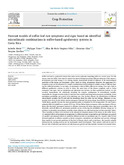Mostrar el registro sencillo del ítem
Forecast models of coffee leaf rust symptoms and signs based on identified microclimatic combinations in coffee-based agroforestry systems in Costa Rica
| dc.contributor.author | Merle, Isabelle | |
| dc.contributor.author | Tixier, Philippe | |
| dc.contributor.author | Virginio Filho, Elías de Melo | |
| dc.contributor.author | Gilas, Chistian | |
| dc.contributor.author | Avelino, Jacques | |
| dc.date.accessioned | 2020-10-22T19:21:37Z | |
| dc.date.available | 2020-10-22T19:21:37Z | |
| dc.date.issued | 2019 | |
| dc.identifier.uri | https://doi.org/10.1016/j.cropro.2019.105046 | |
| dc.identifier.uri | https://repositorio.catie.ac.cr/handle/11554/9736 | |
| dc.description.abstract | Coffee leaf rust is a polycyclic disease that causes severe epidemics impacting yield over several years. For this reason, since the 1960s, more than 20 models have been developed to predict different indicators of the disease’s development and help manage it. In existing models, standardized periods of influence of the meteorological predictors of the disease are determined a priori, based on strong assumptions. However, the appearance of a symptom or sign can be influenced by complex combinations of meteorological variables acting at different times and for different durations. In our study, we monitored a total of 5400 coffee leaves during a year and a half, in different agroforestry systems, in order to detect the onset dates of the disease symptoms, such as lesion emergence, and signs, such as sporulation and infectious area increase. In these agroforestry systems, we also recorded microclimate. We statistically identified the complex combinations of microclimatic variables responsible for changes in lesion status to construct three models predicting lesion emergence probability, lesion sporulation probability and growth of its infectious area. Our method allowed the identification of different microclimatic variables that fit well with the knowledge about the coffee leaf rust biology. Minimum air temperature from 20 to 18 days before a lesion emergence explained the status change from healthy to emergence of visible lesion, possibly because the short germination phase is stimulated by low temperatures. We also found a unimodal effect of rainfall over a period of 10 days, 33 days before lesion emergence, with a maximum at 10 mm. | es_ES |
| dc.language.iso | en | es_ES |
| dc.publisher | Elsevier, Ámsterdam (Países Bajos) | es_ES |
| dc.relation.ispartof | Crop Protection | es_ES |
| dc.rights | info:eu-repo/semantics/openAccess | es_ES |
| dc.subject | CAFE ARABICA | es_ES |
| dc.subject | ROYA DEL CAFE | es_ES |
| dc.subject | MICROCLIMA | es_ES |
| dc.subject | SISTEMAS AGROFORESTALES | es_ES |
| dc.subject | AGRICULTORES | es_ES |
| dc.subject | PREVENCION DEL RIESGO | es_ES |
| dc.subject | CONTROL DE ENFERMEDADES | es_ES |
| dc.subject | AGRO METEREOLOGIA | es_ES |
| dc.subject | EXPERIMENTOS DE CAMPO | es_ES |
| dc.subject | HEMILEIA VASTATRIX | es_ES |
| dc.subject | COSTA RICA | es_ES |
| dc.title | Forecast models of coffee leaf rust symptoms and signs based on identified microclimatic combinations in coffee-based agroforestry systems in Costa Rica | es_ES |
| dc.type | Artículo | es_ES |


